Spanish commands are formed with the imperative mood. To put it another way, the Spanish imperative is a verb conjugation used to give direct orders, instructions or advice, or instructions, and make requests to someone.
Commands are key for many daily life interactions. So, in this guide, you’ll learn how to form and use the imperative mood in Spanish. Here is an overview of the topics we’ll cover:
- Conjugating Imperative Verbs in Spanish
- Irregular Imperatives
- Commands with Pronouns in Spanish
- How to Use the Imperative
- Bonus: Conjugation Tips for the Imperative
- Key Points
- Practice Quiz
- Downloadable PDF
A word of encouragement: Learning new conjugations can seem overwhelming. Good news, though! You already know certain rules that you can leverage to form the imperative. There may be some endings you probably don’t know yet, but you’ll be able to learn them quickly and use them as your Spanish improves. 🙂
How to Form Commands in Spanish
Spanish commands are classified into affirmative and negative commands:
- Positive commands: we order someone to do something.
- Negative commands: we request someone not to do something.
The imperative in Spanish ONLY has four forms (subjects):
- Tú (informal)
- Usted (formal)
- Vosotros (informal)
- Ustedes (formal)
When giving commands in Spanish, we address people directly. As a result, you can only conjugate the imperative with the subject pronouns listed above. Additionally, depending on who you’re addressing, you’d use commands formally, informally, in plural or singular form.
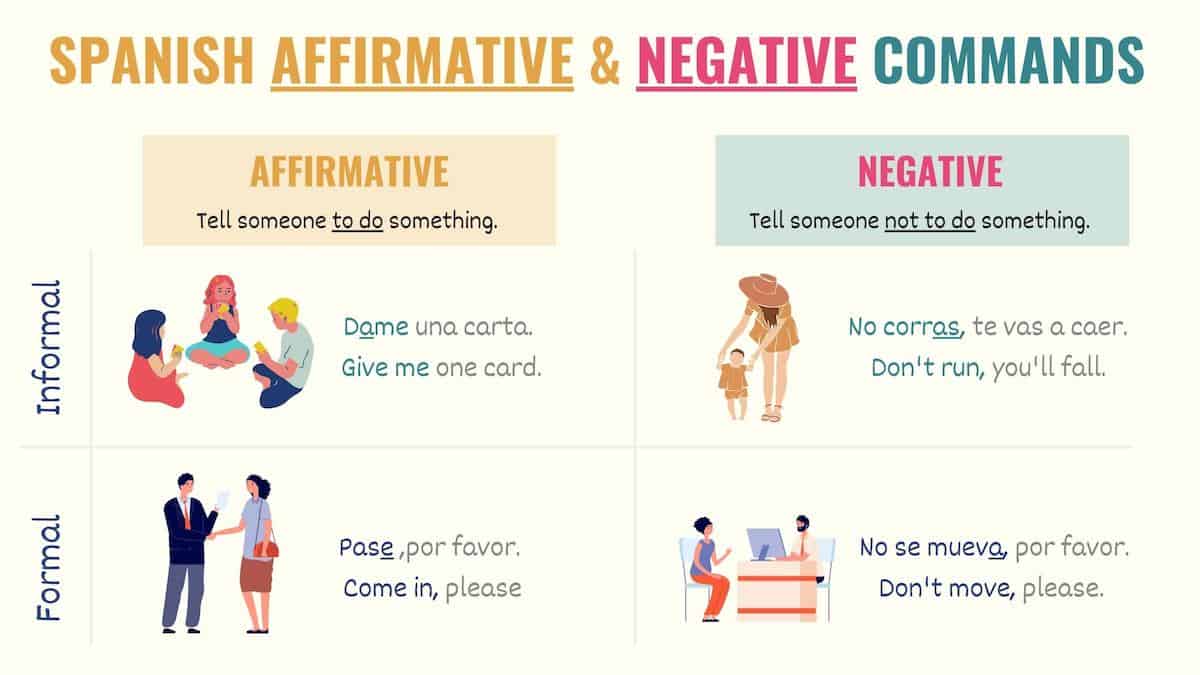
In the sections below, you’ll find the endings and conjugation rules to form the imperative in Spanish.
Take Note: The imperative is not a Spanish tense but rather a mood. A verb mood is the manner in which an action can be expressed. In Spanish, there are three moods – indicative, subjunctive, and imperative.
Spanish affirmative commands
Affirmative commands, also known as positive commands, are used to tell someone to do something. Here is a table with the endings for affirmative commands in Spanish. Notice that you’ll use the same endings for –er and -ir verbs.
| Subject | -AR verbs | -ER / -IR verbs |
|---|---|---|
| Tú | -a | -e |
| Usted | -e | -a |
| Vosotros* | -d | -d |
| Ustedes | -en | -an |
Note: To conjugate vosotros, replace the ‘r’ of the infinitive form with a ‘d’. For example, ‘hablar’ would become ‘hablad’.
Using formal or informal commands in Spanish is related to choosing between formal and informal ‘you’. Use informal Spanish commands (tú) with friends, relatives, and people your age. Use formal affirmative commands to show deference and respect.
Informal command:
¡Abre la puerta, Clara!
Clara, open the door!
Formal command:
Señora, abra la puerta, por favor.
Ma’am, open the door, please.
Tip: Notice that in the table above, the affirmative endings for ‘tú’ and ‘usted’ swap the present endings. To put it simply, in the imperative, the present endings for -AR verbs will be used for -ER/-IR verbs, and vice versa.
If, instead of addressing a single person, you need to tell a group of people what to do, you’ll use plural commands (‘ustedes’ and ‘vosotros’).
Prestad atención, chicos.
Pay attention, guys.
Apaguen las luces, por favor.
Turn the lights off, please.
Take Note: Although the imperative only has four accepted forms, you may also find sentences with nosotros. These commands express what we must or should do and are formed using the present subjunctive form of ‘nosotros’. The imperative of ‘nosotros’ means “let’s [do something]”, and it’s not nearly as common as the other imperative forms.
Hablemos con ella.
Let’s talk with her.
Corramos más tarde, por favor.
Let’s run later, please.
Negative commands
The Spanish negative imperative is used to order someone not to do something. To do this, you must place no before the conjugated verb. The endings to form the negative imperative are:
| Subject | -AR verbs | -ER / -IR verbs |
|---|---|---|
| Tú | -es | -as |
| Usted | -e | -a |
| Vosotros | -éis | -áis |
| Ustedes | -en | -an |
Below are some examples of how to use the negative imperative. Although ‘no’ is the most common negative word we use in situations where we’re giving commands, we can also use other negative words such as nunca and jamás.
[Negative word] + [negative imperative]
No le digas nada a tu hermana.
Don’t say anything to your sister.
No comáis comida chatarra.
Don’t eat junk food.
Nunca hablen con extraños.
Never speak with strangers.
No se preocupe, su orden ya casi está lista.
Don’t worry, your order is almost ready.
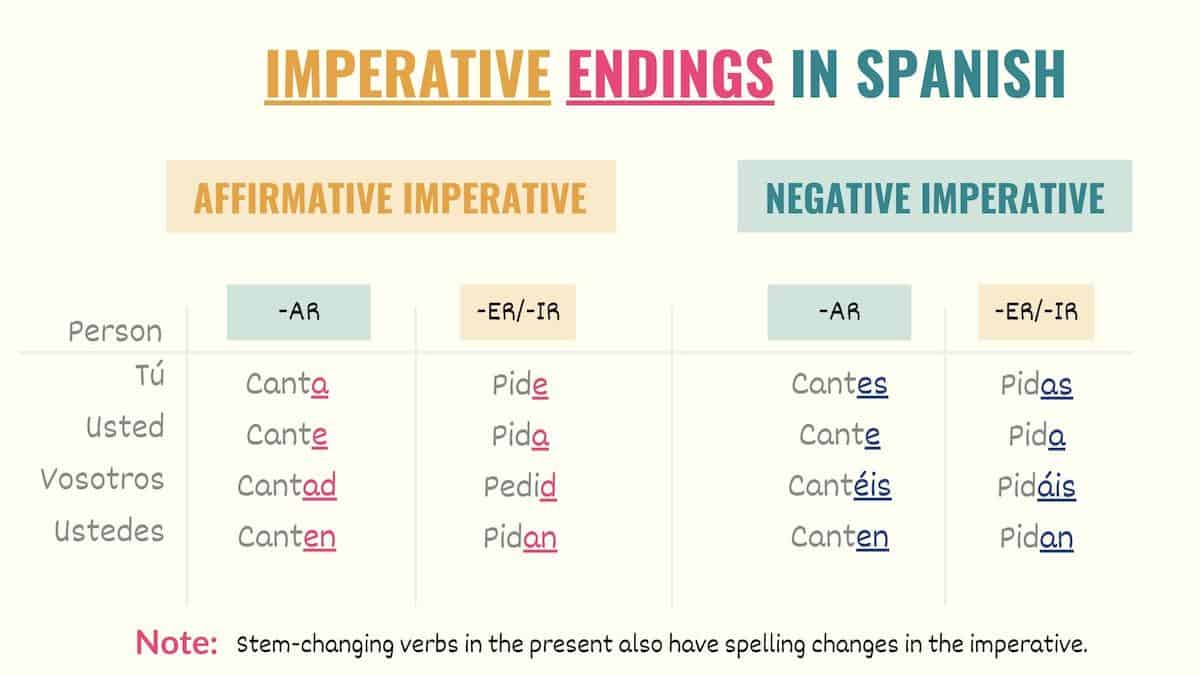
Take Note: The negative imperative endings are the same endings you’ll use to conjugate the present subjunctive.
Irregular Imperative in Spanish
Irregular imperatives for informal affirmative commands (tú) include the following verbs:
- Venir – Ven
- Decir – Di
- Salir – Sal
- Hacer – Haz
- Tener – Ten
- Venir – Ven
- Poner – Pon
- Saber/Ser – Sé
- Ir – Ve
A few years ago, I saw a mnemonic that can help you remember most of these irregular imperatives:
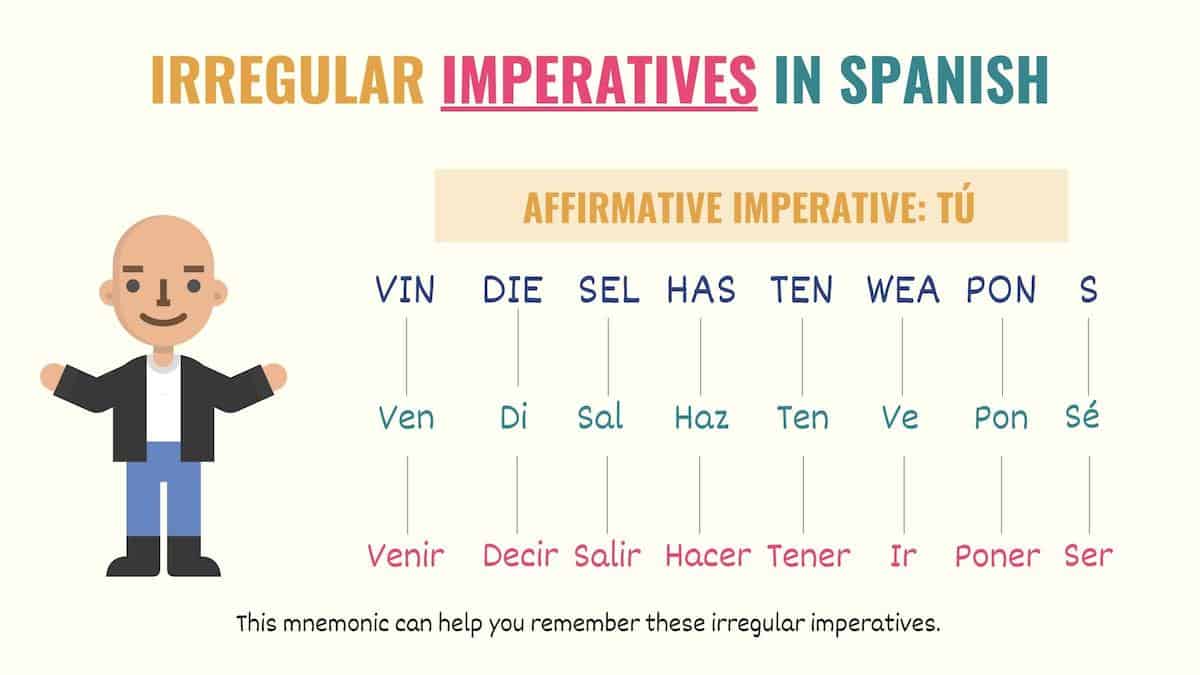
Irregular imperatives for ‘usted’ and ‘ustedes’ also have a key pattern. In the present tense, certain verbs are only irregular in the first person (yo). Those verbs also affect the imperative forms of ustedes and usted.
In other words, the subject pronouns usted and ustedes reuse the irregular stems we use in the present tense form of ‘yo’. Check these examples. ‘Yo pongo’, ‘yo tengo’ and ‘yo digo’ become:
Pongan eso en su lugar.
Put that back in its place.
Tenga sus papeles listos.
Have your papers ready.
No diga eso.
Do not say that.
The irregular patterns for ‘usted’ and ‘ustedes’ you learned above do not apply to ‘ser’ and ‘ir’:
| Verb | Imperative ‘usted’ | Imperative ‘ustedes’ |
|---|---|---|
| Ser | Sea | Sean |
| Ir | Vaya | Vayan |
Tip: Remember that to form the negative imperative for ‘tú’, you simply need to add an ‘s’ to the endings for usted.
¡No seas grosero!
Don’t be rude!
Oye, no vayas al centro, está llenísimo.
Don’t go downtown; it’s crowded.
Take Note: As you’ve probably noticed, most imperative conjugations are based on the present tense. This means that stem-changing verbs in the present tense will have the same spelling changes in the imperative. Look at these examples with dormir and cerrar:
Duérmete, por favor.
Go to sleep, please.
No cierren la puerta.
Don’t close the door.
Attaching pronouns to commands in Spanish
When giving commands in Spanish, certain verbs require you to work with direct object or reflexive pronouns. However, there are some placement rules you must keep in mind.
With Spanish affirmative commands, the pronoun must be attached to the verb:
Bañáte.
Shower.
Ciérralas, por favor.
Close them, please.
Díganos en qué podemos ayudarle.
Tell us how we can help you.
If you’re using both direct and indirect object pronouns, you’ll still attach the pronouns to the verb, but you’ll use this order:
[Imperative verb] + [indirect object pronoun] + [direct object pronoun]
Comételas.
Eat them.
Dáselo.
Give them to him.
On the other hand, negative commands have the pronouns placed in front of the conjugated verb:
[No] + [pronoun] + [imperative verb]
No te las comas.
Don’t eat them.
No la abras.
Don’t open it.
Accent rules for Spanish commands
As you probably noticed, most imperative verbs with a pronoun attached to them have an accent mark. If the stressed syllable is placed in the third or fourth syllable, we must add a written accent.
The graphic below can help you understand these accent rules:
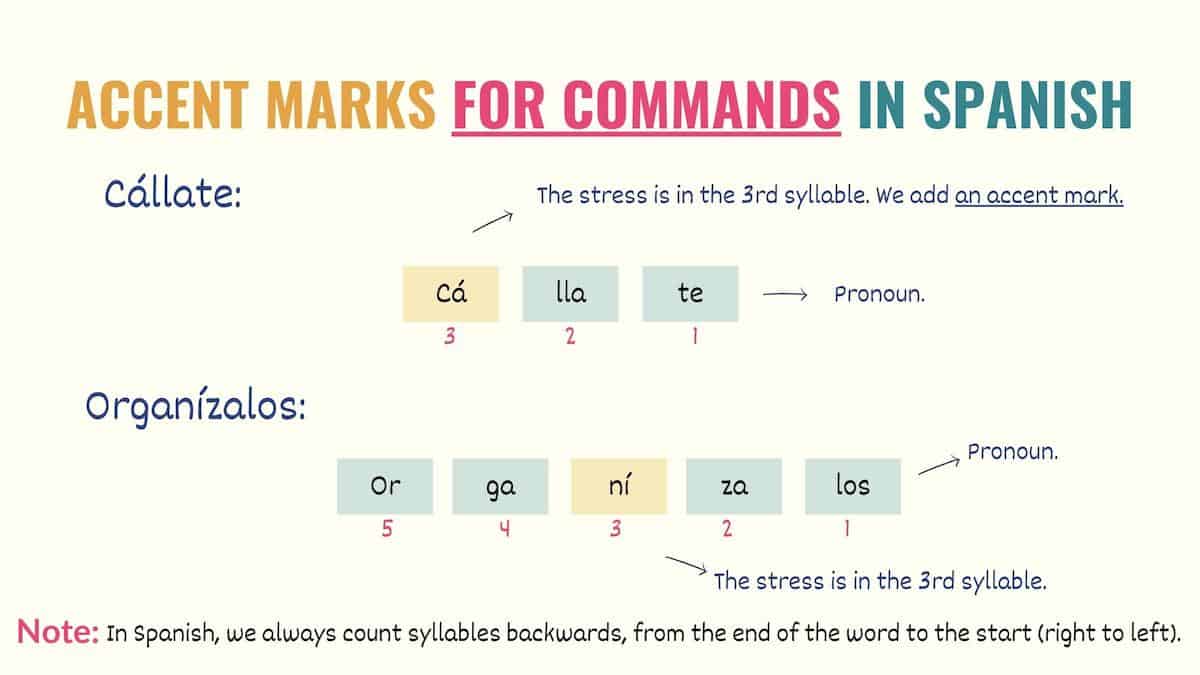
Commands with less than two syllables do not have an accent:
Dame otra papa.
Give me another chip.
Take Note: Dé is the only command with one syllable with an accent mark. This exception distinguishes between the command and the preposition ‘de’.
How & When to Use the Imperative in Spanish
The imperative in Spanish is used to:
- Give direct orders and instructions
Lea las instrucciones con cuidado.
Read the instructions carefully.
Dele estas formas a mi compañera.
Give these forms to my colleague.
- Make suggestions or requests
Perdóname, por favor.
Forgive me, please.
Abran las ventanas si tienen calor.
Open the windows if you’re warm.
- Give advice
Mejor no le digas nada.
You better not say anything.
Llega cinco minutos antes.
Arrive five minutes early.
Based on these applications, you may use the imperative in Spanish to instruct others, such as in user manuals, recipes, emails, or when commanding someone to do something.
Tip: Spanish infinitives can also be used to give commands or instructions without addressing someone in particular. You can find these instructions on signs in libraries and buildings. For example, ‘no fumar’, ‘no correr’, etc.
Bonus: 8 Conjugation Tips for the Spanish Imperative Mood
If you’re struggling with learning more endings, here are some conjugation tips that can make Spanish commands easier to conjugate.
Affirmative commands
- Affirmative commands with ‘vosotros’ are formed by replacing the ‘r’ of the infinitive verb with ‘d’.
Niños, id con su papá.
Kids, go with your dad.
¡Empezad! tenéis treinta minutos.
Start, you have thirty minutes.
- Informal commands (tú) are heavily based on the present tense form of ‘tú’. Delete the ‘s’ from the present tense conjugation to form the imperative. For example, tú corres becomes:
Corre más rápido.
Run faster.
- Formal commands in Spanish (usted) use the third-person singular form of the present subjunctive. Your wish is my command is a cool and easy phrase you can use to remember that the subjunctive and imperative share some similarities. Follow these steps if you haven’t learned the subjunctive conjugation:
- Take the conjugation for ‘yo’ in the present tense.
- For -AR verbs, replace the present ending (‘o’) with the imperative ending ‘e’.
- For -ER and -IR verbs, replace the present ending with the imperative ending ‘a’.
Pase, por favor.
Come in, please.
Escriba su nombre.
Write your name.
- Plural commands with ustedes are also heavily based on the present tense. To form the imperative, we’ll take the present endings and swap them. In other words, the present endings for -AR verbs will be used for -ER/-IR verbs, and vice versa.
Ustedes comen and ustedes cantan become:
Coman verdura.
Eat vegetables.
Canten más alto.
Sing lauder.
- Since the imperative takes after the present tense, the imperative forms reflect stem changes.
Siéntese, por favor.
Sit, please.
Lleguen temprano, por favor.
Arrive early, please.
Negative commands
- Usted and ustedes use the same endings as the Spanish affirmative imperative.
Tomen asiento.
Have a seat.
No tomen más coca.
Don’t drink more coke.
- To form negative informal commands (tú,) add an ‘s’ to the endings for ‘usted’.
Usted negative command:
No abra la puerta.
Don’t open the door.
Tú negative command:
No abras la ventana.
Don’t open the window.
- With negative commands for ‘vosotros’ we swap the present tense endings. In other words, the -ER endings for the present tense will be used for -AR verbs in the imperative form and vice versa. So, vosotros habláis and vosotros bebéis become:
No habléis en clase.
Don’t talk in class.
No bebáis eso.
Don’t drink that.
Key Points
The Spanish imperative is applied in many daily life situations. Here are some key points you should keep in mind:
- The imperative in Spanish is a verb form used to give commands, instructions, advice, suggestions, and requests.
- In Spanish, the imperative is used with four subject pronouns: tú, usted, vosotros, and ustedes.
- Affirmative commands are used to tell people what to do, whereas negative commands tell people what not to do.
- The imperative endings are the same for -ER and -IR verbs.
- With affirmative commands, direct, indirect, and reflexive pronouns must be attached to the verb.
- Commands with more than two syllables have an accent on the vowel of the stressed syllable.
- Infinitives in Spanish are used to give commands on written signs.
Practice Quiz: Spanish Commands
If you want to practice the imperative, you should take this quiz on Spanish imperatives.
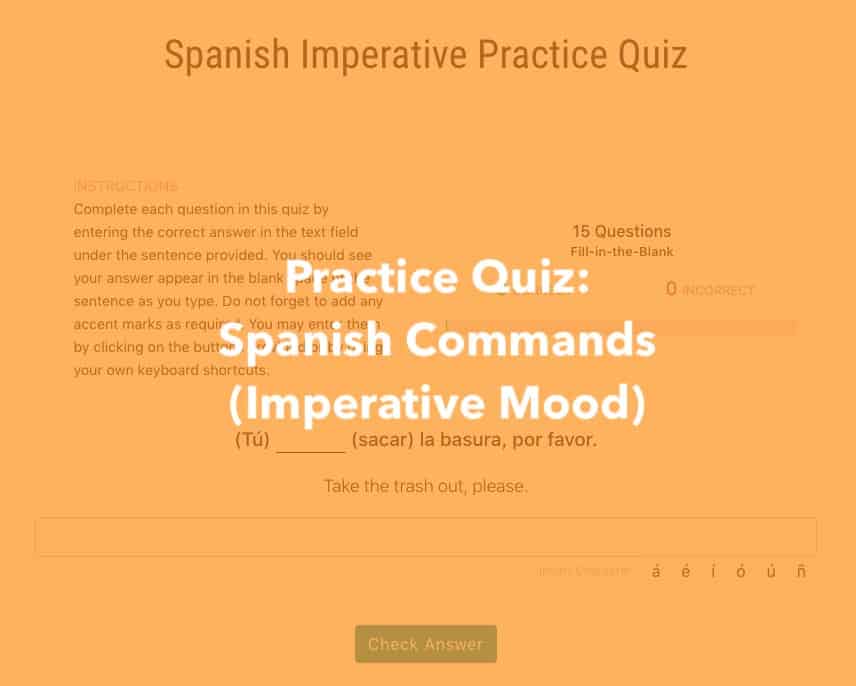
Download the Spanish Commands & Imperative Mood Cheat Sheets
Remembering all of the rules, tips and conjugations for the Spanish Imperative mood can be tricky. Please feel free to download the PDF with notes, graphics, conjugations, and key points on understanding and using commands in Spanish!

